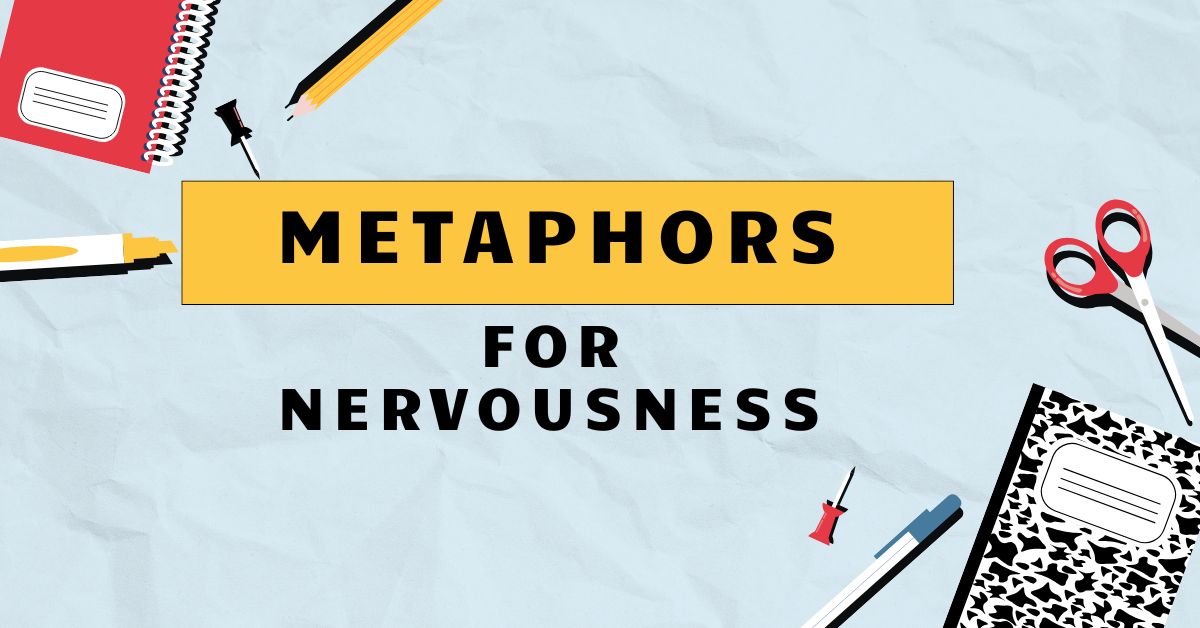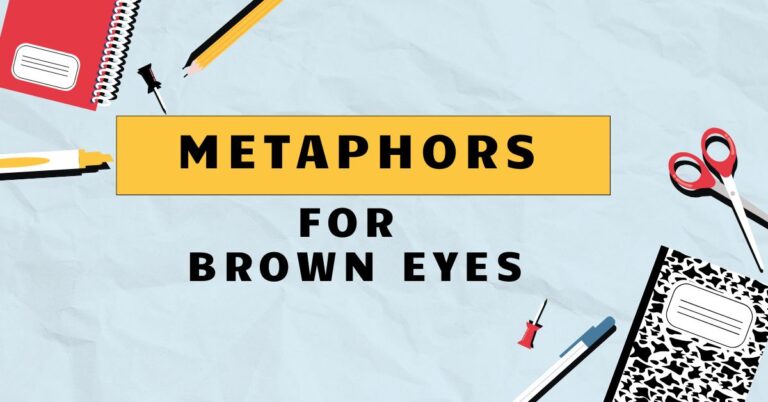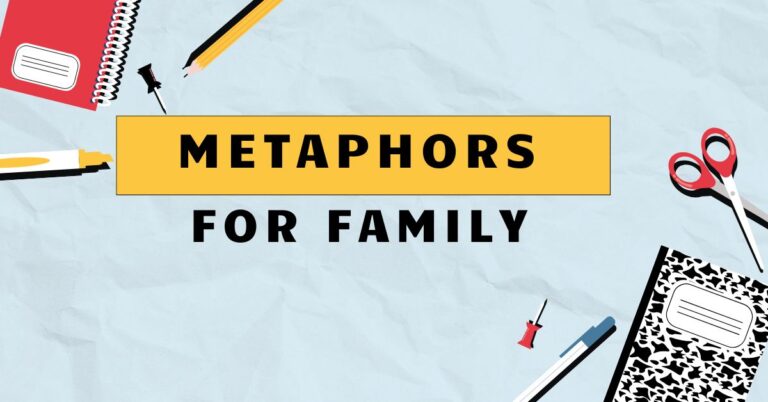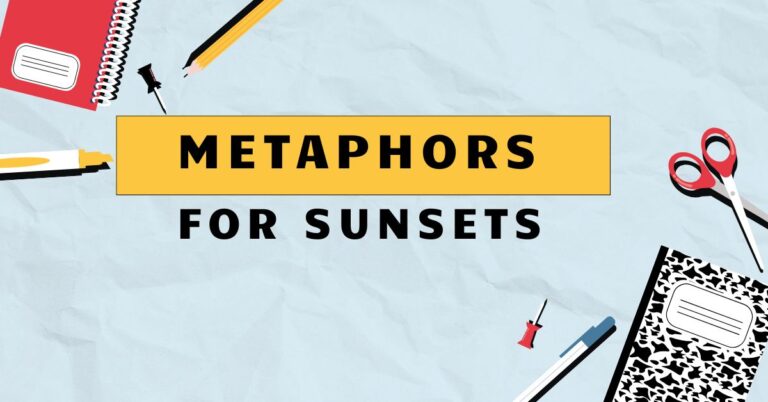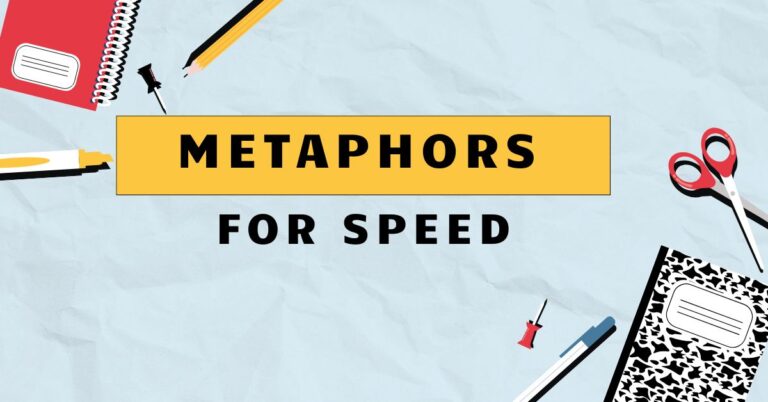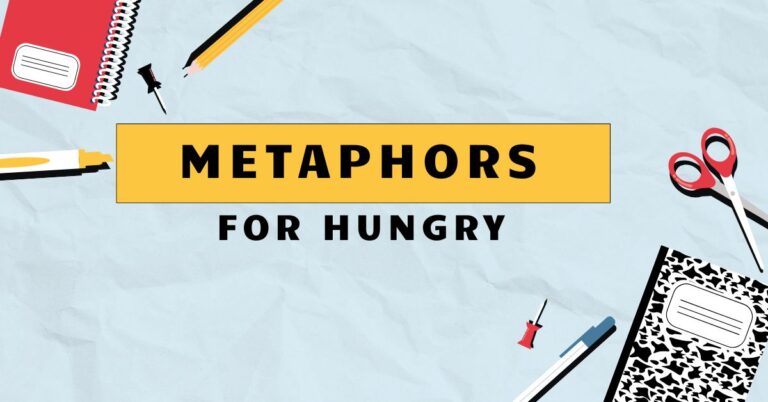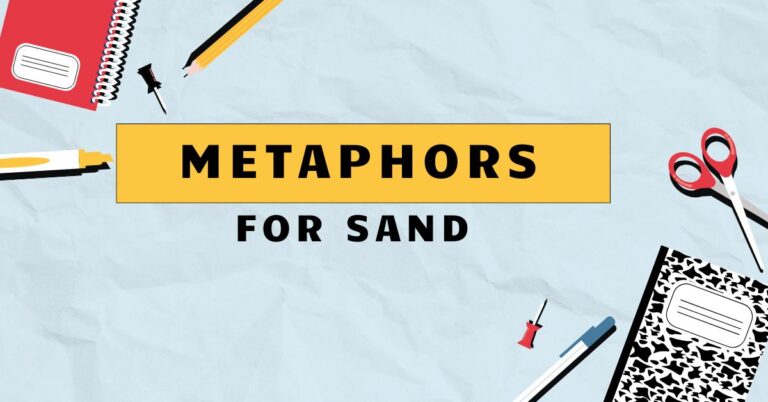39 Metaphors for Nervousness: Expressing Anxiety Figuratively
Understanding how to express nervousness through metaphors is crucial for enhancing both your expressive abilities and your comprehension of English literature and everyday communication. Metaphors allow us to convey complex emotions and internal states in a vivid and relatable way.
This knowledge is beneficial for students, writers, speakers, and anyone looking to articulate their feelings or understand the nuances of emotional expression in the English language. By mastering these metaphorical expressions, you can add depth and color to your language, making it more impactful and engaging.
This article will guide you through the various types of metaphors used to describe nervousness, their structural elements, usage rules, and common mistakes to avoid. Through numerous examples and practical exercises, you’ll gain a solid understanding of how to effectively use metaphors to depict nervousness in your writing and speech.
Table of Contents
- Definition of Metaphors for Nervousness
- Structural Breakdown of Nervousness Metaphors
- Types and Categories of Nervousness Metaphors
- Examples of Metaphors for Nervousness
- Usage Rules for Metaphors of Nervousness
- Common Mistakes When Using Metaphors for Nervousness
- Practice Exercises
- Advanced Topics: Nuances and Subtleties
- Frequently Asked Questions
- Conclusion
Definition of Metaphors for Nervousness
A metaphor is a figure of speech that directly compares two unrelated things, asserting that one thing *is* the other to suggest a likeness or analogy between them. When applied to nervousness, metaphors help us describe the feeling of anxiety, apprehension, or unease by likening it to something more tangible or universally understood.
These metaphors don’t literally mean that someoneisa shaking leaf, but they convey the idea that the person feels shaky and insecure, much like a leaf in a strong wind.
The function of metaphors in describing nervousness is to provide a more vivid and relatable understanding of an otherwise abstract emotion. Nervousness can be a deeply personal and subjective experience, making it difficult to articulate.
Metaphors bridge this gap by offering concrete imagery that resonates with others, allowing them to empathize with and comprehend the speaker’s or writer’s feelings. Metaphors also add a layer of creativity and emotional impact to language, making it more engaging and memorable.
Metaphors for nervousness can be found in various contexts, including literature, poetry, everyday conversation, and professional settings. In literature, authors use metaphors to create a specific mood or to reveal a character’s inner turmoil.
In everyday conversation, people often use metaphors to express their feelings in a more colorful and descriptive way. In professional settings, metaphors can be used to communicate stress or anxiety in a relatable manner, such as describing a project deadline as a “pressure cooker.”
Structural Breakdown of Nervousness Metaphors
Understanding the structural components of a metaphor is essential for effectively using them. A metaphor typically consists of two main elements: thetenorand thevehicle.
The tenor is the subject being described (in this case, nervousness), and the vehicle is the object or concept used to describe the tenor. The connection between the two is the shared characteristic or quality that makes the comparison meaningful.
For instance, in the metaphor “His stomach was a knot,” the tenor is the feeling of nervousness in his stomach, and the vehicle is a knot. The shared characteristic is the feeling of tightness, discomfort, and tension.
The effectiveness of a metaphor depends on how well the vehicle conveys the intended meaning and how clearly the shared characteristic is understood.
Metaphors can also beexplicitorimplicit. An explicit metaphor directly states the comparison using words like “is,” “as,” or “like.” For example, “Her voice was like a trembling leaf” is an explicit metaphor.
An implicit metaphor, on the other hand, implies the comparison without directly stating it. For example, “His hands trembled, leaves in a storm,” is an implicit metaphor where the comparison between his trembling hands and leaves in a storm is implied.
The structure of a metaphor can also involve extended metaphors, where the comparison is developed over several sentences or even an entire paragraph. This allows for a more detailed and nuanced exploration of the shared characteristics between the tenor and the vehicle.
For example, an author might use an extended metaphor to compare a character’s nervousness to a storm, detailing the rising tension, the sudden outbursts, and the eventual calm that follows.
Types and Categories of Nervousness Metaphors
Metaphors for nervousness can be categorized based on the type of imagery they evoke. Here are some common categories:
Animal Metaphors
Animal metaphors often draw on the instinctive reactions and physical characteristics of animals to represent nervousness. These metaphors can convey feelings of vulnerability, fear, or agitation.
Weather Metaphors
Weather metaphors use natural atmospheric phenomena to symbolize the internal state of nervousness. These metaphors can express feelings of turbulence, instability, or impending doom.
Physical Sensation Metaphors
Physical sensation metaphors relate nervousness to tangible physical sensations, such as discomfort, pressure, or instability. These metaphors can help convey the immediate and visceral experience of anxiety.
Mechanical Metaphors
Mechanical metaphors use the imagery of machines and their malfunctions to represent the feeling of being overwhelmed or breaking down due to nervousness. These metaphors often convey a sense of loss of control.
Nature Metaphors
Nature metaphors go beyond weather to include other aspects of the natural world, like plants, landscapes, or natural processes, to describe nervousness. These can illustrate feelings of fragility, growth under pressure, or being uprooted.
Examples of Metaphors for Nervousness
The following tables provide extensive examples of metaphors for nervousness, categorized by type. Each example demonstrates how a specific image or concept can be used to convey the feeling of anxiety or unease.
Table 1: Animal Metaphors for Nervousness
This table illustrates how animal characteristics and behaviors are used to describe the feeling of nervousness. Each metaphor uses the animal’s traits to highlight a specific aspect of anxiety, such as restlessness, fear, or vulnerability.
| Metaphor | Explanation |
|---|---|
| He was a caged tiger, pacing back and forth. | Describes restlessness and pent-up energy due to nervousness. |
| She felt like a deer caught in headlights. | Conveys a sense of being frozen with fear and vulnerability. |
| My stomach was full of butterflies. | A common metaphor for the fluttering sensation of nervousness. |
| He was as jumpy as a cat on a hot tin roof. | Describes extreme nervousness and agitation. |
| She felt like a trapped bird, desperate to escape. | Conveys a feeling of being confined and anxious to break free. |
| His nerves were like a hive of bees, buzzing with anxiety. | Describes a constant and irritating feeling of nervousness. |
| She was as timid as a mouse, afraid to speak up. | Conveys shyness and reluctance due to nervousness. |
| He felt like a fish out of water. | Describes feeling uncomfortable and out of place, causing anxiety. |
| Her heart was pounding like a drum, a frantic rhythm of fear. | Emphasizes the physical manifestation of nervousness. |
| He was sweating like a pig before the presentation. | Describes excessive sweating due to anxiety. |
| She felt like a lamb to the slaughter. | Conveys a sense of impending doom and helplessness. |
| He was as nervous as a long-tailed cat in a room full of rocking chairs. | Describes a situation filled with potential danger and anxiety. |
| She felt like a cornered rat, ready to fight or flee. | Conveys desperation and a fight-or-flight response. |
| His voice was as shaky as a newborn foal’s legs. | Describes the physical manifestation of nervousness in his voice. |
| She was as quiet as a church mouse. | Conveys shyness and reluctance to draw attention due to nervousness. |
| He felt like a snake about to shed its skin, uncomfortable and exposed. | Describes a feeling of vulnerability and transformation. |
| She was as watchful as a hawk, scanning for any sign of trouble. | Conveys heightened awareness and anxiety. |
| He felt like a scared rabbit, ready to bolt at any moment. | Describes a constant state of alert and fear. |
| Her thoughts were like squirrels in a cage, running around in circles. | Conveys scattered and unproductive thinking due to nervousness. |
| He was as fidgety as a hummingbird, unable to stay still. | Describes restlessness and inability to focus due to nervousness. |
| She felt like a lone wolf, isolated and anxious. | Conveys a sense of isolation and vulnerability. |
| He was as nervous as a turkey on Thanksgiving. | Describes a feeling of impending doom in a humorous way. |
| She felt like a spider caught in its own web, trapped by her anxiety. | Conveys a feeling of being ensnared by one’s own fears. |
| He was as skittish as a wild horse, easily startled. | Describes a state of heightened sensitivity and fear. |
| Her heart fluttered like a hummingbird’s wings. | Emphasizes the rapid and erratic heartbeat caused by nervousness. |
| He felt like a caged bird longing for freedom. | Conveys a feeling of confinement and a desire to escape the situation. |
| She was as hesitant as a kitten exploring a new room. | Describes a cautious and uncertain approach due to nervousness. |
| He felt like a snail without its shell, completely exposed. | Conveys a feeling of vulnerability and lack of protection. |
| Her voice was as weak as a baby bird’s chirp. | Describes a faint and trembling voice caused by nervousness. |
Table 2: Weather Metaphors for Nervousness
This table provides weather-related metaphors that illustrate the turbulent and unpredictable nature of nervousness. These metaphors highlight the feeling of being overwhelmed, unstable, or caught in a storm of emotions.
| Metaphor | Explanation |
|---|---|
| He felt a storm brewing inside him. | Describes an increasing sense of anxiety and tension. |
| She was a whirlwind of nerves. | Conveys a chaotic and agitated state of mind. |
| His thoughts were scattered like leaves in a hurricane. | Describes disorganized and overwhelming thoughts. |
| She felt like she was walking on thin ice. | Conveys a sense of risk and potential danger. |
| His anxiety was a dark cloud hanging over him. | Describes a persistent and oppressive feeling of nervousness. |
| She felt like a fragile boat in a stormy sea. | Conveys a sense of vulnerability and being overwhelmed. |
| His nerves were frayed like the edges of a tattered sail in a gale. | Describes a feeling of being worn down and vulnerable. |
| She was caught in a downpour of worries. | Conveys being overwhelmed by numerous anxieties. |
| He felt the pressure building like a thundercloud. | Describes an increasing sense of tension and impending stress. |
| She was as shaky as a leaf in a strong wind. | Conveys physical trembling due to nervousness. |
| His mind was a fog of anxiety. | Describes a state of confusion and disorientation due to nervousness. |
| She felt like a drought of confidence had dried up her courage. | Conveys a lack of self-assurance and bravery. |
| He was swept away by a tidal wave of panic. | Describes being overwhelmed by a sudden surge of anxiety. |
| She felt the chill of fear run down her spine like a winter wind. | Conveys a physical sensation of fear and unease. |
| His voice was as shaky as the ground during an earthquake. | Describes the physical manifestation of nervousness in his voice. |
| She was caught in a blizzard of doubt. | Conveys being overwhelmed by uncertainty and insecurity. |
| He felt like the calm before the storm, a deceptive moment of peace. | Describes a brief respite before an impending crisis. |
| She was drowning in a sea of anxiety. | Conveys being overwhelmed and suffocated by worry. |
| His mind was a desert of despair, barren and hopeless. | Describes a state of emptiness and hopelessness due to nervousness. |
| She felt like a rainbow after the storm, fragile and unsure. | Conveys a sense of vulnerability and uncertainty after a stressful event. |
| He was navigating a treacherous landscape of fear. | Describes the challenges and difficulties of dealing with anxiety. |
| She felt the ground shifting beneath her feet, destabilized by fear. | Conveys a sense of insecurity and instability. |
| His thoughts were swirling like a tornado, destructive and uncontrollable. | Describes chaotic and overwhelming thoughts due to nervousness. |
| She was standing on the edge of a cliff of anxiety, afraid to fall. | Conveys a sense of impending doom and vulnerability. |
| He felt like he was lost in a dense fog of apprehension. | Describes a state of confusion and uncertainty due to fear. |
| She was weathering the storm of her emotions, trying to stay afloat. | Conveys the effort and resilience required to manage anxiety. |
| His heart was pounding like distant thunder, a warning of the storm to come. | Emphasizes the physical manifestation of nervousness. |
| She was caught in the crosswinds of conflicting emotions. | Conveys the struggle of dealing with multiple anxieties at once. |
| He felt like he was walking through a minefield of potential disasters. | Describes a situation filled with hidden dangers and anxieties. |
Table 3: Physical Sensation Metaphors for Nervousness
This table presents metaphors that link the abstract feeling of nervousness to concrete physical sensations. These metaphors help to express the immediate and visceral experience of anxiety, making it more relatable and understandable.
| Metaphor | Explanation |
|---|---|
| His stomach was a knot. | Describes a feeling of tightness and discomfort in the stomach. |
| She felt a cold sweat break out on her forehead. | Conveys a physical manifestation of anxiety. |
| His heart was racing a mile a minute. | Describes a rapid heartbeat due to nervousness. |
| She felt a lump in her throat. | Conveys difficulty speaking due to anxiety. |
| His hands were clammy with fear. | Describes sweaty hands as a sign of nervousness. |
| She felt a shiver run down her spine. | Conveys a physical sensation of fear and unease. |
| His muscles were tense, ready to spring. | Describes physical tension due to anxiety. |
| She felt like she was going to jump out of her skin. | Conveys extreme restlessness and agitation. |
| His breath caught in his chest. | Describes difficulty breathing due to anxiety. |
| She felt a wave of nausea wash over her. | Conveys a physical sensation of sickness due to nervousness. |
| His head was swimming with anxiety. | Describes a feeling of dizziness and disorientation. |
| She felt like her insides were twisting. | Conveys a feeling of inner turmoil and discomfort. |
| His throat was dry as sandpaper. | Describes difficulty swallowing due to anxiety. |
| She felt a pressure building behind her eyes. | Conveys a physical sensation of tension and stress. |
| His legs felt like lead. | Describes a feeling of heaviness and difficulty moving. |
| She felt like her blood was turning to ice. | Conveys a physical sensation of fear and shock. |
| His skin was crawling with anxiety. | Describes a feeling of unease and restlessness. |
| She felt like she was suffocating under the weight of her worries. | Conveys a feeling of being overwhelmed and unable to breathe. |
| His stomach was doing somersaults. | Describes a feeling of unease and agitation in the stomach. |
| She felt like her heart was going to beat out of her chest. | Describes a rapid and intense heartbeat due to nervousness. |
| His palms were slick with perspiration. | Describes sweaty palms as a physical manifestation of anxiety. |
| She felt a tightening in her chest. | Conveys a physical sensation of pressure and discomfort. |
| His voice was a mere croak. | Describes a hoarse and strained voice due to nervousness. |
| She felt like her body was vibrating with tension. | Conveys a physical sensation of restlessness and agitation. |
| His face was flushed with anxiety. | Describes a physical manifestation of nervousness in his appearance. |
| She felt like her nerves were on fire. | Conveys a heightened sense of agitation and discomfort. |
| His breathing was shallow and rapid. | Describes a physical manifestation of anxiety. |
| She felt like her muscles were coiled springs, ready to snap. | Conveys a sense of tension and impending release. |
| His teeth were chattering uncontrollably. | Describes a physical manifestation of fear and nervousness. |
Table 4: Mechanical Metaphors for Nervousness
This table explores metaphors that use mechanical imagery to describe the feeling of nervousness. These metaphors often convey a sense of being overwhelmed, breaking down, or losing control, similar to how a machine might malfunction under stress.
| Metaphor | Explanation |
|---|---|
| He felt like his engine was revving too high. | Describes a feeling of being overstimulated and anxious. |
| She felt like her gears were grinding to a halt. | Conveys a sense of being unable to function properly. |
| His mind was a runaway train. | Describes thoughts that are out of control and overwhelming. |
| She felt like her circuits were overloaded. | Conveys a sense of being overwhelmed and unable to process information. |
| His nerves were wires frayed and sparking. | Describes a heightened state of agitation and instability. |
| She felt like her battery was running low. | Conveys a sense of exhaustion and lack of energy. |
| His thoughts were spinning like a broken record. | Describes repetitive and unproductive thinking. |
| She felt like her system was crashing. | Conveys a sense of being completely overwhelmed and unable to cope. |
| His composure was a fragile machine, threatening to break down. | Describes a precarious state of emotional stability. |
| She felt like she was running on empty. | Conveys a sense of depletion and exhaustion. |
| His mind was a tangled web of wires. | Describes a state of confusion and disorganization. |
| She felt like her programming was malfunctioning. | Conveys a sense of being unable to behave normally. |
| His emotions were a pressure cooker about to explode. | Describes a buildup of tension and impending outburst. |
| She felt like she was short-circuiting under the stress. | Conveys a sense of being overwhelmed and unable to function. |
| His thoughts were racing like a high-speed engine. | Describes rapid and uncontrollable thoughts. |
| She felt like her internal clock was ticking too fast. | Conveys a sense of urgency and anxiety. |
| His body was a machine running on fumes. | Describes a state of exhaustion and depletion. |
| She felt like she was stuck in a loop, unable to escape her anxiety. | Conveys a sense of being trapped in repetitive thoughts. |
| His mind was a factory churning out worries. | Describes a constant stream of anxious thoughts. |
| She felt like her safety valve was about to burst. | Conveys a sense of impending emotional breakdown. |
| His nerves were a delicate clockwork, easily disrupted. | Describes a fragile state of emotional balance. |
| She felt like her system was overheating. | Conveys a sense of being overwhelmed and stressed. |
| His thoughts were like cogs grinding against each other. | Describes internal conflict and friction. |
| She felt like she was running out of memory, unable to process more information. | Conveys a sense of being overwhelmed and unable to cope. |
| His mind was a switchboard overloaded with calls. | Describes a state of chaos and disorganization. |
| She felt like her hard drive was crashing. | Conveys a sense of complete system failure. |
| His words stuttered like a skipping record. | Describes difficulty speaking due to nervousness. |
| She felt like she was stuck in neutral, unable to move forward. | Conveys a sense of stagnation and paralysis. |
Table 5: Nature Metaphors for Nervousness
This table presents metaphors based on elements of nature, such as plants, landscapes, and natural processes, to describe nervousness. These metaphors can illustrate feelings of fragility, growth under pressure, or being uprooted, providing a deeper understanding of the emotional experience.
| Metaphor | Explanation |
|---|---|
| He felt like a sapling in a storm, bending but not breaking. | Describes resilience in the face of adversity. |
| She felt like a wilting flower, losing her vibrancy. | Conveys a sense of diminished energy and enthusiasm. |
| His thoughts were like tangled vines, choking his clarity. | Describes confusion and difficulty thinking clearly. |
| She felt like she was walking through quicksand, sinking deeper with each step. | Conveys a sense of being overwhelmed and trapped. |
| His nerves were like brittle branches, ready to snap. | Describes a fragile state of emotional stability. |
| She felt like a seed buried too deep, struggling to sprout. | Conveys a sense of being stifled and unable to grow. |
| His mind was a barren landscape, devoid of inspiration. | Describes a lack of creativity and motivation. |
| She felt like she was adrift at sea, lost and without direction. | Conveys a sense of disorientation and uncertainty. |
| His emotions were a dormant volcano, threatening to erupt. | Describes a buildup of tension and impending outburst. |
| She felt like she was climbing a mountain of anxiety, each step harder than the last. | Conveys the challenges and difficulties of overcoming anxiety. |
| His thoughts were like shifting sands, unstable and unreliable. | Describes a lack of certainty and consistency. |
| She felt like she was wandering through a dark forest, lost and afraid. | Conveys a sense of being overwhelmed and uncertain. |
| His composure was a fragile ecosystem, easily disrupted. | Describes a delicate balance of emotional stability. |
| She felt like she was drowning in a swamp of despair, unable to escape. | Conveys a sense of being trapped and overwhelmed by negative emotions. |
| His mind was a garden overgrown with weeds of worry. | Describes a state of anxiety and disarray. |
| She felt like she was caught in a web of thorns, unable to move freely. | Conveys a sense of being trapped and restricted. |
| His emotions were a raging river, carrying him away. | Describes being overwhelmed by intense feelings. |
| She felt like she was standing on shaky ground, vulnerable and exposed. | Conveys a sense of insecurity and instability. |
| His thoughts were like falling leaves, drifting aimlessly. | Describes a lack of focus and direction. |
| She felt like she was weathering a drought of hope, parched and despairing. | Conveys a lack of optimism and motivation. |
| His nerves were like tangled roots, difficult to untangle. | Describes a complex and overwhelming state of anxiety. |
| She felt like she was lost in a labyrinth of fear, unable to find her way out. | Conveys a sense of being trapped and disoriented. |
| His mind was a desert of silence, devoid of comfort. | Describes a state of isolation and despair. |
| She felt like she was standing at the edge of a precipice, afraid to look down. | Conveys a sense of impending doom and vulnerability. |
| His thoughts were like seeds of doubt, sprouting and growing. | Describes the insidious nature of anxiety and uncertainty. |
| She felt like she was adrift on a raft of uncertainty, tossed by waves of doubt. | Conveys a sense of being vulnerable and without direction. |
| His dreams were a forest of shadows, filled with hidden fears. | Describes the presence of anxiety even in sleep. |
Usage Rules for Metaphors of Nervousness
When using metaphors to describe nervousness, it’s crucial to follow certain guidelines to ensure clarity and effectiveness. Here are some key usage rules:
- Clarity: The metaphor should be easily understood and relatable to the audience. Avoid obscure or overly complex comparisons that might confuse the reader or listener.
- Relevance: The vehicle (the object or concept used in the metaphor) should have a clear and logical connection to the tenor (nervousness). The shared characteristic should be evident and meaningful.
- Originality: While common metaphors can be effective, strive for originality to make your writing or speech more engaging and memorable. Avoid clichés that have lost their impact through overuse.
- Consistency: Maintain consistency in your metaphors. Avoid mixing metaphors that create conflicting or nonsensical images.
- Context: Consider the context in which you are using the metaphor. The appropriateness of a metaphor can depend on the audience, the tone of the communication, and the overall message.
- Subtlety: Use metaphors judiciously. Overuse can make your writing or speech feel forced and unnatural.
Exceptions and Special Cases:
While these rules are generally applicable, there are exceptions and special cases to consider. For example, in poetry or creative writing, authors may intentionally use unconventional or abstract metaphors to create a specific effect or to challenge the reader’s expectations.
In such cases, the emphasis may be on evoking a particular mood or feeling rather than on strict logical coherence.
Common Mistakes When Using Metaphors for Nervousness
Several common mistakes can undermine the effectiveness of metaphors for nervousness. Being aware of these pitfalls can help you avoid them and use metaphors more skillfully.
- Mixed Metaphors: Combining two or more unrelated metaphors that create a confusing or nonsensical image.
- Incorrect: “He was skating on thin ice while also juggling burning coals.”
- Correct: “He was skating on thin ice.” or “He was juggling burning coals.”
- Clichés: Using overused and predictable metaphors that have lost their impact.
- Incorrect: “He had butterflies in his stomach.” (While understandable, it’s a common cliché.)
- Correct: “His stomach churned with a swarm of anxious bees.”
- Inappropriate Metaphors: Using metaphors that are insensitive, offensive, or inappropriate for the context.
- Incorrect: (Using a metaphor that trivializes serious anxiety issues.)
- Correct: (Choosing a metaphor that is respectful and sensitive to the emotional state being described.)
- Lack of Clarity: Using metaphors that are too abstract or obscure for the audience to understand.
- Incorrect: “His anxiety was a fractal dimension of existential dread.”
- Correct: “His anxiety was a deep chasm, separating him from peace.”
- Overuse: Using too many metaphors in a short space, which can make the writing feel forced and unnatural.
- Incorrect: (A paragraph filled with multiple metaphors, making it difficult to follow.)
- Correct: (Using metaphors sparingly and strategically to enhance the writing.)
Practice Exercises
Test your understanding of metaphors for nervousness with these practice exercises. Identify the type of metaphor used in each sentence and, if necessary, rewrite the sentence to improve the effectiveness of the metaphor.
Exercise 1: Identifying Metaphor Types
Identify the type of metaphor (animal, weather, physical sensation, mechanical, or nature) used in each sentence.
| Question | Answer |
|---|---|
| 1. Her voice was as shaky as a leaf in a strong wind. | Weather Metaphor |
| 2. He felt like a caged tiger, pacing back and forth. | Animal Metaphor |
| 3. His stomach was a knot. | Physical Sensation Metaphor |
| 4. She felt like her circuits were overloaded. | Mechanical Metaphor |
| 5. He felt like a sapling in a storm, bending but not breaking. | Nature Metaphor |
Exercise 2: Improving Metaphor Effectiveness
Rewrite the following sentences to improve the effectiveness of the metaphor. Consider clarity, relevance, and originality.
Advanced Topics: Nuances and Subtleties
Mastering metaphors for nervousness involves understanding their subtle nuances and how they can be tailored to convey specific shades of meaning. Consider these advanced topics to deepen your understanding:
- Cultural Context: Metaphors can have different meanings and connotations in different cultures. Be aware of the cultural context when using metaphors, especially when communicating with diverse audiences.
- Personal Experience: The effectiveness of a metaphor can depend on the personal experiences of the audience. Consider how your audience might interpret the metaphor based on their own background and perspective.
- Emotional Intensity: Tailor your metaphors to reflect the intensity of the nervousness you are describing. A mild feeling of unease might be described with a gentle metaphor, while severe anxiety might require a more dramatic and intense comparison.
- Combining Metaphors: Experiment with combining different types of metaphors to create a more complex and nuanced description. For example, you might combine a weather metaphor with a physical sensation metaphor to convey both the emotional and physical aspects of nervousness.
- Originality vs. Familiarity: Striking a balance between originality and familiarity is key. While originality can make your metaphors more engaging, familiarity ensures that they are easily understood.
Frequently Asked Questions
Conclusion
Metaphors are powerful tools for expressing the complex emotion of nervousness in a vivid and relatable way. By understanding the structural components of metaphors, exploring different categories, following usage rules, and avoiding common mistakes, you can enhance your ability to articulate feelings of anxiety and unease.
Through practice and attention to detail, you can master the art of using metaphors to add depth, color, and emotional impact to your writing and speech. Whether you’re a student, writer, speaker, or simply someone looking to improve your communication skills, mastering metaphors for nervousness will undoubtedly enrich your expressive abilities and deepen your understanding of the English language.

